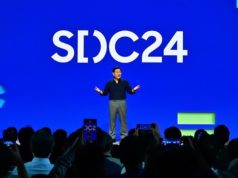MIAMI, Fla – If you travel to any South American or Caribbean country you are likely to see something that is “rigged,” whether it be an interesting contraption, or a catch-all solution for a common problem that seems impossibly clever and incredibly efficient. Latino culture has melded and improvised from multiple influences, so this innate sense of innovation shouldn’t surprise anybody.
But but it took Puerto Rican/Cuban American Ric Herrero, director of Maker Faire Miami, to recognize the ways in which we can harness it to make our communities – and around the globe that much more innovative, interesting and cohesive. Maker Faire started in the San Francisco area in 2006 and has since expanded worldwide; it’s a family friendly event that touts itself as “part science fair, part country fair.”
We sat with Herrero to talk about all things Maker ahead of this year’s Maker Faire Miami, co-produced by Miami Dade College, taking place in the most pan-Latin of America’s cities: Miami.
What is a Maker Faire?
It’s an all ages festival of DIY enthusiasts in tech, arts and crafts; everything from coders and robotics to chocolatiers and jewelry designers. It’s a festival of educators and people that teach others how to make things or how to use Maker center learning to help develop a sense of agency and character in students young and old while showcasing their creations to the community at large.
I like to think of it as a ground level snapshot of our innovation ecosystem.


What inspired you to bring Maker Faire to Miami?
I remember thinking in Miami there’s a lot of really great people making interesting things but they’re sort of spread out, working in their own silos. Maker Faires are sprouting all over the world right now, wouldn’t it be something to bring that event to Miami to celebrate local creators.
Ultimately, Maker Faire reflects the local community and Miami is the gateway to the Americas. We have the opportunity not only to showcase Latino American talent but also to strengthen our ties and facilitate collaboration with the Maker communities in Costa Rica, Colombia, Peru, Cuba all of Latin America.


What do you think makes Miami such a creative city?
In part, necessity. It’s a DIY town. By and large there is no industry that employs thousands of knowledge workers in Miami. So you have a lot of small businesses who have to make themselves stand out and in many ways it’s through creative endeavors.
What impact do you hope to have on Miami and Latin America through Maker Faire?
We’ve seen tons of Maker activity sprouting throughout the community as well as a growing number of schools working to introduce Maker learning into their curriculum. But its impact can also be seen in how Miami is growing.
Urban hacking has its roots in the Maker movement. Take Biscayne Green, the temporary re-imagining of a stretch of Biscayne Boulevard. All its components were fabricated in local makerspaces. The activation was used to help the city envision what that area could be instead of just being a parking lot. They saw they could use that area to forge communal bonds, to promote mass transit and walkable spaces. It’s success has inspired and facilitated similar urban hacking projects projects in other cities.


Who are your top five Latino Makers that we should be on the lookout for this year?
We’ve got Latino creators presenting everything from self-driving cars to panama hats. Almost half of our 150 Makers are Latino. But if you’re going to limit me to five, I would start with these:
Santiago Peralta, Founder, Pacari Chocolate (Ecuador). He’s the founder of an Ecuadorian chocolate company that has revolutionized the industry by creating a transparent model of tree-to-bar manufacturing based on innovation, social responsibility and direct trade with certified organic farms.
Diego Ruiz Sanchez, CEO, Tyre Barrier (Colombia & Spain) will present their innovative design, this barrier made of tyre crumb aims to reduce traffic deaths while reusing a product difficult to make disappear, since it doesn’t allow motocyclists and cyclists to go off of the road if an accident takes place.
Josuhe Pagliery, Animator and video game designer, Savior (Cuba) is co-creator of Savior, the first independent Cuban video game, to be released in 2018.
Laura Lozano Lominchar, Founder, CEO of CHARGY (Spain) will be – with her powerful, business intelligence tool that analyzes data in real-time through a wireless hardware device designed to be installed in businesses, offices and public spaces.
Jose Villa, Raiko Valladares and Romy Martinez, VIBRA Studio (Cuba), based in Havana and Miami. It’s based on the revitalization and reuse of common and accessible materials – wood, metals, plastic ropes and ceramics – to generate new and experimental concepts in furniture and home goods.
Josie Goytisolo, Founder of Codella (Miami) the first-in-the-nation, 8-week Tech Entrepreneurship & Coding Immersion Program for under-represented Latina girls from the ages 8-12.
RELATED: CODeLLA Aims to Teach Latina Girls Another Vital Language: Coding
Lastly, the Latin American sub-network of FabLabs has joined forces to produce the Fab LAT Pavilion which features projects such as the FabCity Global Initiative (Tomas Diez, Venezuela-Spain), FabLatKids (Alejandra Diaz, Mexico), Floating Fab Lab (Beno Juarez, Peru), Fab Loom (Walter Gonzales, Peru), FAB13 (Tomas Vivanco, Chile), Fab Textile (Anastasia Pistofidou, Greece-Spain-Chile), Fab Lab Móvil (Robert Garita, Costa Rica), Laboratorios de Creación and Insitu (Juan Vallejo, Colombia), Reaccion.net and Chunchebot (Emilio Velis, El Salvador).
Maker Faire Miami will take place on April 8th and 9th, 2017. Purchase tickets now via Eventbrite.
…







